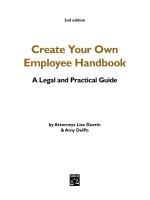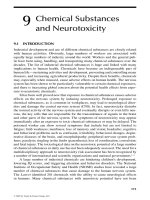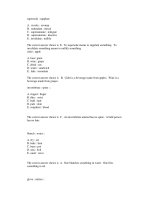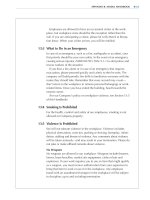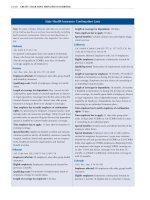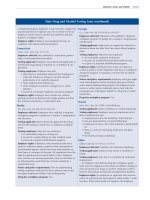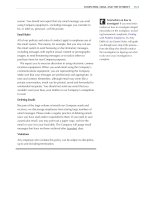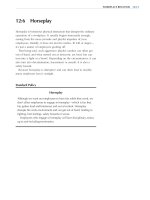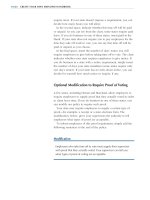create your own employee handbook a legal and practical guide phần 9 doc
Bạn đang xem bản rút gọn của tài liệu. Xem và tải ngay bản đầy đủ của tài liệu tại đây (415.8 KB, 51 trang )
21/18 CREATE YOUR OWN EMPLOYEE HANDBOOK
Note: The states of Alaska, Delaware and Idaho are not included
in this chart because they do not have laws specifically controlling
health insurance continuation. Check your state department of
labor if you need more information (See Appendix C for contact
list).
Alabama
Ala. Code § 27-55-3 (4)
No general continuation laws, but subjects of domestic
abuse, who have lost coverage under abuser’s plan and
who do not qualify for COBRA, may have 18 months
coverage (applies to all employers).
Arizona
Ariz. Rev. Stat. Ann. §§ 20-1377, 20-1408
Employers affected: All employers who offer group health
and disability insurance.
Qualifying event: Death of employee; change in marital
status.
Length of coverage for dependents: May convert to indi-
vidual policy upon death of covered employee or divorce
or legal separation. Coverage must be the same unless the
insured chooses a lesser plan. (Insurer may offer group
insurance as long as there is no change in coverage.)
Time employer has to notify employee of continuation
rights: No provisions for employer. Insurance policy must
include notice of conversion privilege. Clerk of court must
provide notice to anyone filing for divorce that dependent
spouse is entitled to convert health insurance coverage.
Time employee has to apply: 31 days after termination of
existing coverage.
Special benefits: Applies to blanket accident and sickness
insurance policies and to all disability insurance issued by
hospital, medical, dental and optometric service corpora-
tions, healthcare services organizations and fraternal
benefit societies.
Arkansas
Ark. Code Ann. §§ 23-86-114 to 23-86-116
Employers affected: All employers who offer group health
insurance.
Eligible employees
: Employees continuously insured for
previous 3 months.
Qualifying event
: Termination of employment; death of
employee; change in marital status.
Length of coverage for employee
: 120 days.
Length of coverage for dependents: 120 days.
Time employee has to apply
: 10 days.
Special benefits: Excludes: dental care; prescription drugs;
vision services.
California
Cal. Health & Safety Code §§ 1373.6, 1373.621; Cal. Ins.
Code §§ 10128.50 to 10128.59
Employers affected: Employers with 2 to 19 employees.
Eligible employees
: Employees continuously insured for
previous 3 months.
Qualifying event
: Termination of employment; reduction in
hours.
Length of coverage for employee
: 18 months; 29 months if
disabled at termination or during first 60 days of continua-
tion coverage. (Employee also has choice of converting to
an individual insurance plan.)
Length of coverage for dependents
: 18 months; 29 months
if disabled at termination or during first 60 days of continu-
ation coverage; 36 months upon death of employee, divorce
or legal separation, loss of dependent status, employee’s
eligibility for Medicare. (Dependents also have choice of
converting to an individual insurance plan.)
Time employer has to notify employee of continuation
rights
: 15 days.
Time employee has to apply
: 31 days after group plan
ends; 30 days after COBRA or Cal-COBRA ends (63 days
if converting to an individual plan).
Special benefits
: Includes vision and dental benefits (if the
employer offers them).
Special situations
: Employee who is 60 or older and has
worked for employer for previous 5 years may continue
benefits for self and spouse beyond COBRA or Cal-COBRA
limits (also applies to COBRA employers). Beginning 9/1/03,
any employee who began receiving COBRA coverage on
or after 1/1/03 and whose coverage is for less than 36
months, is entitled to additional continuation coverage to
total 36 months.
Colorado
Colo. Rev. Stat. § 10-16-108
Employers affected
: All employers who offer group health
insurance.
Eligible employees
: Employees continuously insured for
previous 3 months. (If eligible due to reduction in hours,
State Health Insurance Continuation Laws
ENDING EMPLOYMENT 21/19
must have been continuously insured for previous 6
months.)
Qualifying event
: Termination of employment; reduction in
hours; death of employee; change in marital status.
Length of coverage for employee
: 18 months.
Length of coverage for dependents: 18 months.
Time employer has to notify employee of continuation
rights
: Within 10 days of termination of coverage.
Time employee has to apply
: 31 days after termination of
coverage.
Special benefits
: Excludes: specific diseases; accidental
injuries.
Connecticut
Conn. Gen. Stat. Ann. §§ 38a-538, 38a-554; § 31-51o
Employers affected
: All employers who offer group health
insurance.
Eligible employees
: Employees continuously insured for
previous 3 months.
Qualifying event
: Layoff; reduction in hours; termination of
employment; death of employee; change in marital status.
Length of coverage for employee
: 18 months.
Length of coverage for dependents
: 18 months; 36 months
in case of employee’s death or divorce.
Time employer has to notify employee of continuation
rights
: 14 days.
Time employee has to apply
: 60 days.
Special benefits: Excludes: specific diseases; accidental
injuries.
Special situations
: When facility closes or relocates, employer
must pay for insurance for employee and dependents for
120 days or until employee is eligible for other group cov-
erage, whichever comes first. (Does not affect employee’s
right to regular continuation coverage which begins when
120-day period ends.)
District of Columbia
D.C. Code Ann. §§ 32-731 to 32-732
Employers affected: Employers with fewer than 20
employees.
Eligible employees
: All insured employees are eligible.
Qualifying event
: Any reason employee or dependent
becomes ineligible for coverage.
Length of coverage for employee
: 3 months.
Length of coverage for dependents: 3 months.
Time employer has to notify employee of continuation
rights: Within 15 days of termination of coverage.
Time employee has to apply: 45 days after termination of
coverage.
Special benefits
: Excludes: dental or vision only insurance.
Florida
Fla. Stat. Ann. § 627.6692
Employers affected
: Employers with fewer than 20
employees.
Eligible employees
: Full-time (25 or more hours per week)
employees covered by employer’s health insurance plan.
Qualifying event
: Layoff; reduction in hours; termination of
employment; death of employee; change in marital status.
Length of coverage for employee
: 18 months.
Length of coverage for dependents
: 18 months.
Time employer has to notify employee of continuation
rights
: Carrier notifies employee within 14 days of learning
of qualifying event (employer is responsible for notifying
carrier).
Time employee has to apply
: 30 days from receipt of
carrier’s notice.
Georgia
Ga. Code Ann. §§ 33-24-21.1 to 33-24-21.2
Employers affected: All employers who offer group health
insurance.
Eligible employees
: Employees continuously insured for
previous 6 months.
Qualifying event
: Termination of employment (except for
cause).
Length of coverage for employee
: 3 months plus any part
of the month remaining at termination.
Length of coverage for dependents
: 3 months plus any part
of the month remaining at termination.
Special situations
: Employee, spouse or former spouse,
who is 60 or older and who has been covered for previous
6 months may continue coverage until eligible for Medicare.
(Applies to companies with more than 20 employees; does
not apply when employee quits for reasons other than
health.)
Hawaii
Haw. Rev. Stat. § 393-15
Employers affected: All employers required to offer health
insurance (those paying a regular employee a monthly
State Health Insurance Continuation Laws (continued)
21/20 CREATE YOUR OWN EMPLOYEE HANDBOOK
wage at least 86.67 times the state hourly minimum
wage—about $542).
Qualifying event: Employee is hospitalized or prevented by
sickness from working.
Length of coverage for employee: Employer must pay
insurance premiums for 3 months or for as long employer
continues to pay employee’s wages, whichever is longer.
Illinois
215 Ill. Comp. Stat. §§ 5/367e, 5/367.2
Employers affected: All employers who offer group health
insurance.
Eligible employees
: Employees continuously insured for
previous 3 months.
Qualifying event
: Termination of employment.
Length of coverage for employee
: 9 months.
Length of coverage for dependents: 9 months.
Time employee has to apply
: 10 days after termination or
receiving notice from employer, whichever is later, but not
more than 60 days from termination.
Special benefits
: Excludes: dental care; prescription drugs;
vision services; disability income; specified diseases.
Special situations
: Upon death or divorce, 2 years cover-
age for spouse under 55; until eligible for Medicare or
other group coverage for spouse over 55.
Indiana
Ind. Code Ann. § 27-8-15-31.1
Employers affected: Employers with 2 to 50 employees.
Eligible employees
: Employed by same employer for at
least one year and continuously insured for previous 90
days.
Qualifying event
: Termination of employment; reduction in
hours; dissolution of marriage; loss of dependent status.
Length of coverage for employee
: 12 months.
Length of coverage for dependents: 12 months.
Time employer has to notify employee of continuation
rights
: 10 days after employee becomes eligible for con-
tinuation coverage.
Time employee has to apply
: Must apply directly to insurer
within 30 days after becoming eligible for continuation
coverage.
Iowa
Iowa Code §§ 509B.3 to 509B.5
Employers affected
: All employers who offer group health
insurance.
Eligible employees
: Employees continuously insured for
previous 3 months.
Qualifying event
: Any reason employee or dependent
becomes ineligible for coverage.
Length of coverage for employee
: 9 months.
Length of coverage for dependents: 9 months.
Time employer has to notify employee of continuation
rights
: 10 days after termination of coverage.
Time employee has to apply
: 10 days after termination of
coverage or receiving notice of continuation rights from
employer, whichever is later, but no more than 31 days
from termination of coverage.
Special benefits
: Excludes: dental care; prescription drugs;
vision services.
Kansas
Kan. Stat. Ann. § 40-2209(i)
Employers affected: All employers who offer group health
insurance.
Eligible employees
: Employees continuously insured for
previous 3 months.
Qualifying event
: Any reason employee or dependent
becomes ineligible for coverage.
Length of coverage for employee
: 6 months.
Length of coverage for dependents: 6 months.
Time employee has to apply
: 31 days from termination of
coverage.
Kentucky
Ky. Rev. Stat. Ann. § 304.18-110
Employers affected: All employers who offer group health
insurance.
Eligible employees
: Employees continuously insured for
previous 3 months.
Qualifying event
: Any reason employee or dependent
becomes ineligible for coverage.
Length of coverage for employee
: 18 months.
Length of coverage for dependents: 18 months.
Time employer has to notify employee of continuation
rights
: Employer must notify insurer as soon as employee’s
coverage ends; insurer then notifies employee.
State Health Insurance Continuation Laws (continued)
ENDING EMPLOYMENT 21/21
Time employee has to apply: 31 days from receipt of
insurer’s notice.
Special benefits
: Excludes: specific diseases; accidental
injury.
Louisiana
La. Rev. Stat. Ann. §§ 22:215.7, 22:215.13
Employers affected: All employers who offer group health
insurance.
Eligible employees
: Employees continuously insured for
previous 3 months.
Qualifying event
: Termination of employment.
Length of coverage for employee: 12 months.
Length of coverage for dependents
: 12 months.
Time employee has to apply: Must apply and submit pay-
ment before group coverage ends.
Special benefits
: Excludes: dental care; vision care; specific
diseases; accidental injury.
Special situations
: Surviving spouse who is 50 or older may
have coverage until remarriage or eligibility for Medicare
or other insurance.
Maine
Me. Rev. Stat. Ann. tit. 24-A, § 2809-A
Employers affected
: All employers who offer group health
insurance.
Eligible employees
: Employees continuously insured for
previous 3 months.
Qualifying event
: Termination of employment.
Length of coverage for employee
: One year (either group
or individual coverage at discretion of insurer).
Length of coverage for dependents
: One year (either group
or individual coverage at discretion of insurer). Upon death
of insured, continuation only if original plan provided for
coverage.
Time employee has to apply
: 90 days from termination of
group coverage.
Special situations
: Temporary layoff or work-related injury
or disease: Employee and dependents entitled to one year
group or individual continuation coverage. (Must have
been continuously insured for previous 6 months; must
apply within 31 days.)
Maryland
Md. Code Ann., [Ins.] §§ 15-407 to 15-410
Employers affected
: All employers who offer group health
insurance.
Eligible employees
: Employees continuously insured for
previous 3 months.
Qualifying event
: Involuntary termination of employment;
death of employee; change in marital status.
Length of coverage for employee
: 18 months.
Length of coverage for dependents: 18 months upon death
of employee; upon change in marital status, 18 months or
until spouse remarries or becomes eligible for other cover-
age.
Time employer has to notify employee of continuation
rights
: Must notify insurer within 14 days of receiving
employee’s request.
Time employee has to apply: 45 days from termination of
coverage. Employee begins application process by request-
ing an election of continuation notification form from
employer.
Massachusetts
Mass. Gen. Laws ch. 175, §§ 110G, 110I; ch. 176J, § 9
Employers affected
: All employers who offer group health
insurance.; special rules for employers with Small Group
Health Insurance (2 to 19 employees).
Eligible employees
: All insured employees are eligible.
Qualifying event
: Involuntary layoff; death of insured
employee. For Small Group Health Insurance employer
add: reduction in hours; divorce or legal separation; loss of
dependent status; employee’s eligibility for Medicare;
employer’s bankruptcy.
Length of coverage for employee: 39 weeks (but may not
exceed time covered under original coverage).
Small Group Health Insurance employer: 18 months. (29
months if disabled.)
Length of coverage for dependents: 39 weeks. (Divorced
or separated spouse entitled to benefits only if included in
judgment decree.)
Small Group Health Insurance employer: 18 months
upon termination or reduction in hours; 29 months if
disabled; 36 months on divorce, death of employee,
employee’s eligibility for Medicare, employer’s bankruptcy.
Time employer has to notify employee of continuation
rights
: When employee becomes eligible for continuation
benefits.
Time employee has to apply: 30 days. Small Group Health
Insurance employer, 60 days.
State Health Insurance Continuation Laws (continued)
21/22 CREATE YOUR OWN EMPLOYEE HANDBOOK
Special situations: Termination due to plant closing: 90
days coverage for employee and dependents, at the same
payment terms as before closing.
Michigan
Mich. Comp. Laws § 500.3612
Employers affected: All employers offering group health
and disability insurance.
Eligible employees: Employees continuously insured for 3
months.
Qualifying event: Termination of group coverage for any
reason except discharge for gross misconduct.
Length of coverage for employee: Eligible employee and
dependents may convert to an individual policy without
evidence of insurability or regard for preexisting condition.
Time employer has to notify employee of continuation
rights: Within 14 days of termination of coverage.
Time employee has to apply: No later than 30 days from
termination of coverage.
Minnesota
Minn. Stat. Ann. § 62A.17
Employers affected: All employers who offer group health
insurance.
Eligible employees
: All insured employees are eligible.
Qualifying event
: Termination of employment; reduction in
hours.
Length of coverage for employee
: 18 months.
Length of coverage for dependents: 18 months.
Time employer has to notify employee of continuation
rights
: Within 10 days of termination of coverage.
Time employee has to apply
: 60 days from termination of
coverage or receipt of employer’s notice, whichever is
later.
Mississippi
Miss. Code Ann. § 83-9-51
Employers affected: All employers who offer group health
insurance.
Eligible employees
: Employees continuously insured for
previous 3 months.
Qualifying event
: Termination of employment; divorce;
employee’s death; employee’s eligibility for Medicare; loss
of dependent status.
Length of coverage for employee
: 12 months.
Length of coverage for dependents
: 12 months.
Time employer has to notify employee of continuation
rights: Insurer must notify former or deceased employee’s
dependent child or divorced spouse of option to continue
insurance within 14 days of their becoming ineligible for
coverage on employee’s policy.
Time employee has to apply: Employee must apply and
submit payment before group coverage ends; dependents
or former spouse must elect continuation coverage within
30 days of receiving insurer’s notice.
Special benefits
: Excludes: dental and vision care; any
benefits other than hospital, surgical or major medical.
Missouri
Mo. Rev. Stat. § 376.428
Employers affected: All employers who offer group health
insurance.
Eligible employees
: Employees continuously insured for
previous 3 months.
Qualifying event
: Termination of employment.
Length of coverage for employee: 9 months.
Length of coverage for dependents: 9 months.
Time employer has to notify employee of continuation
rights
: No later than date group coverage would end.
Time employee has to apply: 31 days from date group
coverage would end.
Special benefits
: Excludes: dental and vision care; any
benefits other than hospital, surgical or major medical.
Must include: maternity benefits if they were provided
under group policy.
Montana
Mont. Code Ann. §§ 33-22-506 to 33-22-510
Employers affected: All employers who offer group health
insurance.
Eligible employees
: Employees continuously insured for
previous 3 months.
Qualifying event
: Reduction in hours.
Length of coverage for employee: One year. Upon reduc-
tion in hours (with employer’s consent).
Length of coverage for dependents
: One year. Upon
reduction in hours (with employer’s consent).
Time employee has to apply
: 31 days from date group
coverage would end.
State Health Insurance Continuation Laws (continued)
ENDING EMPLOYMENT 21/23
Special situations: Insurer may not discontinue benefits to
child with disabilities after child exceeds age limit for
dependent status.
Nebraska
Neb. Rev. Stat. §§ 44-1640 and following, 44-7406
Employers affected
: Employers not subject to federal
COBRA laws.
Eligible employees
: All insured employees are eligible.
Qualifying event: Involuntary termination of employment
(layoff due to labor dispute not considered involuntary).
Length of coverage for employee
: 6 months.
Length of coverage for dependents: One year upon death
of insured employee.
Time employer has to notify employee of continuation
rights
: Within 10 days of termination of employment must
send notice by certified mail.
Time employee has to apply
: 10 days from receipt of
employer’s notice.
Special situations
: Subjects of domestic abuse, who have
lost coverage under abuser’s plan and who do not qualify
for COBRA, may have 18 months coverage (applies to all
employers).
Nevada
Nev. Rev. Stat. Ann. §§ 689B.245 and following;
689B.0345
Employers affected
: Employers with less than 20 employees.
Eligible employees: Employees continuously insured for
previous 12 months.
Qualifying event
: Involuntary termination of employment;
involuntary reduction in hours; death of employee; divorce
or legal separation; loss of dependent status; employee’s
eligibility for Medicare.
Length of coverage for employee
: 18 months.
Length of coverage for dependents
: 36 months.
Time employer has to notify employee of continuation
rights
: 14 days after receiving notice of employee’s eligibility.
Time employee has to apply: Must notify employer within
60 days of becoming eligible for continuation coverage;
must apply within 60 days after receiving employer’s notice.
Special situations
: Leave without pay due to disability: 12
months for employee and dependents (applies to all
employers).
New Hampshire
N.H. Rev. Stat. Ann. § 415:18(VIIg), (VII-a)
Employers affected
: Employers with 2 to 19 employees.
Eligible employees: All insured employees are eligible.
Qualifying event
: Any reason employee or dependent
becomes ineligible for coverage.
Length of coverage for employee
: 18 months; 29 months if
disabled at termination or during first 60 days of continua-
tion coverage.
Length of coverage for dependents
: 18 months; 29 months
if disabled at termination or during first 60 days of continu-
ation coverage; 36 months upon death of employee, divorce
or legal separation, loss of dependent status, employee’s
eligibility for Medicare.
Time employer has to notify employee of continuation
rights
: Within 15 days of termination of coverage.
Time employee has to apply
: Within 31 days of
termination of coverage.
Special benefits
: Includes dental insurance.
Special situations
: Layoff or termination due to strike: 6
months coverage with option to extend for an additional
12 months. Surviving, divorced or legally separated spouse
who is 55 or older may continue benefits until eligible for
Medicare or other employer-based group insurance.
New Jersey
N.J. Stat. Ann. §§ 17B:27-30, 17B:27-51.12, 17B:27A-27
Employers affected: Employers with 2 to 50 employees.
Eligible employees
: Employed full-time (25 or more hours).
Qualifying event: Termination of employment; reduction in
hours.
Length of coverage for employee
: 12 months.
Length of coverage for dependents
: 180 days upon death
of employee (applies to all employers).
Time employer has to notify employee of continuation
rights
: At time of qualifying event employer or carrier
notifies employee.
Time employee has to apply
: Within 30 days of qualifying
event.
Special benefits
: Coverage must be identical to that offered
to current employees.
Special situations
: Total disability: Employee who has been
insured for previous 3 months and employee’s dependents
State Health Insurance Continuation Laws (continued)
21/24 CREATE YOUR OWN EMPLOYEE HANDBOOK
entitled to continuation coverage that includes all benefits
offered by group policy (applies to all employers).
New Mexico
N.M. Stat. Ann. § 59A-18-16
Employers affected: All employers who offer group health
insurance.
Eligible employees
: All insured employees are eligible.
Qualifying event
: Termination of employment.
Length of coverage for employee: 6 months.
Length of coverage for dependents
: May continue group
coverage or convert to individual policy upon death of
employee, divorce or legal separation
Time employer has to notify employee of continuation
rights
: Must give written notice at time of termination.
Time employee has to apply
: 30 days after receiving
employer’s or insurer’s notice.
New York
N.Y. Ins. Law §§ 3221(f), 3221(m)
Employers affected
: All employers who offer group health
insurance.
Eligible employees
: All insured employees are eligible.
Qualifying event: Termination of employment; death of
employee; divorce or legal separation; loss of dependent
status; employee’s eligibility for Medicare.
Length of coverage for employee
: 18 months; 29 months if
disabled at termination or during first 60 days of continuation
coverage.
Length of coverage for dependents
: 18 months; 29 months
if disabled at termination or during first 60 days of continu-
ation coverage; 36 months upon death of employee, divorce
or legal separation, loss of dependent status, employee’s
eligibility for Medicare.
Time employee has to apply
: 60 days after termination or
receipt of notice, whichever is later.
Special situations
: Employee who has been insured for
previous 3 months and dependents may convert to an
individual plan instead of group continuation (must apply
within 45 days of termination).
Employee who is 60 or older and has been continuously
insured for at least 2 years is entitled to a converted policy
with set maximum premium limits.
North Carolina
N.C. Gen. Stat. §§ 58-53-5 to 58-53-40
Employers affected: All employers who offer group health
insurance.
Eligible employees
: Employees continuously insured for
previous 3 months.
Qualifying event
: Termination of employment.
Length of coverage for employee: 18 months.
Length of coverage for dependents
: 18 months.
Time employer has to notify employee of continuation
rights
: Employer has option of notifying employee as part
of the exit process.
Time employee has to apply
: 60 days.
Special benefits
: Excludes: dental care; prescription drugs;
vision care; any benefits other than hospital, surgical or
major medical.
North Dakota
N.D. Cent. Code §§ 26.1-36-23, 26.1-36-23.1
Employers affected
: All employers who offer group health
insurance.
Eligible employees
: Employees continuously insured for
previous 3 months.
Qualifying event
: Termination of employment.
Length of coverage for employee
: 39 weeks
Length of coverage for dependents: 39 weeks. 36 months if
required by divorce or annulment decree.
Time employee has to apply
: Within 10 days of termination
or of receiving notice of continuation rights, whichever is
later, but no more than 31 days from termination.
Special benefits
: Excludes: dental care; prescription drugs;
vision care; any benefits other than hospital, surgical or
major medical.
Ohio
Ohio Rev. Code Ann. §§ 3923.38; 1751.53
Employers affected
: All employers who offer group health
insurance.
Eligible employees
: Employees continuously insured for
previous 3 months who are entitled to unemployment
benefits.
Qualifying event
: Involuntary termination of employment.
Length of coverage for employee: 6 months.
Length of coverage for dependents
: 6 months.
Time employer has to notify employee of continuation
rights
: At termination of employment.
State Health Insurance Continuation Laws (continued)
ENDING EMPLOYMENT 21/25
Time employee has to apply: Whichever is earlier: 31 days
after coverage terminates; 10 days after coverage terminates
if employer notified employee of continuation rights prior
to termination; 10 days after employer notified employee
of continuation rights, if notice was given after coverage
terminated.
Special benefits
: Excludes: dental care; prescription drugs;
vision care; any benefits other than hospital, surgical or
major medical.
Oklahoma
Okla. Stat. Ann. tit. 36, § 4509
Employers affected
: All employers who offer group health
insurance.
Eligible employees
: Insured for at least 6 months. (All other
employees and their dependents entitled to 30 days con-
tinuation coverage.)
Qualifying event
: Any reason coverage terminates.
Length of coverage for employee: 3 months for basic
coverage, 6 months for major medical at the same premium
rate prior to termination of coverage.
Length of coverage for dependents
: 3 months for basic
coverage, 6 months for major medical at the same premium
rate prior to termination of coverage.
Special benefits
: Includes maternity care.
Oregon
Or. Rev. Stat. §§ 743.600 to 743.610
Employers affected
: Employers not subject to federal
COBRA laws.
Eligible employees
: Employees continuously insured for
previous 3 months.
Qualifying event
: Termination of employment.
Length of coverage for employee
: 6 months.
Length of coverage for dependents: 6 months.
Time employee has to apply
: 10 days after termination or
receiving notice of continuation rights, whichever is later,
but not more than 31 days.
Special benefits
: Excludes: dental care; prescription drugs;
vision care; any benefits other than hospital, surgical or
major medical.
Special situations
: Surviving, divorced or legally separated
spouse who is 55 or older and dependent children entitled
to continuation benefits until spouse remarries or is eligible
for other coverage. Must include dental, vision or prescrip-
tion drug benefits if they were offered in original plan
(applies to employers with 20 or more employees).
Pennsylvania
40 Pa. Cons. Stat. Ann. § 756.2(d)
No laws for continuation insurance. Employees who have
been continuously insured for the previous 3 months may
convert to an individual policy.
Rhode Island
R.I. Gen. Laws §§ 27-19.1-1, 27-20.4-1 to 27.20.4-2
Employers affected
: All employers who offer group health
insurance.
Eligible employees
: All insured employees are eligible.
Qualifying event: Involuntary termination of employment;
death of employee; change in marital status; permanent
reduction in workforce; employer’s going out of business.
Length of coverage for employee
: 18 months (but not
longer than continuous employment).
Length of coverage for dependents
: 18 months (but not
longer than continuous employment).
Time employer has to notify employee of continuation
rights
: Employers must post a conspicuous notice of
employee continuation rights.
Time employee has to apply
: 30 days from termination of
coverage.
Special situations: If right to receive continuing health
insurance is stated in the divorce judgment, divorced spouse
has right to continue coverage as long as employee remains
covered or until divorced spouse remarries or becomes
eligible for other group insurance. If covered employee
remarries, divorced spouse must be given right to purchase
an individual policy from same insurer.
South Carolina
S.C. Code Ann. § 38-71-770
Employers affected: All employers who offer group health
insurance.
Eligible employees
: Employees continuously insured for
previous 6 months.
Qualifying event
: Any reason employee or dependent
becomes ineligible for coverage.
Length of coverage for employee
: 6 months (in addition to
part of month remaining at termination).
Length of coverage for dependents
: 6 months (in addition
to part of month remaining at termination).
State Health Insurance Continuation Laws (continued)
21/26 CREATE YOUR OWN EMPLOYEE HANDBOOK
Time employer has to notify employee of continuation
rights
: At time of termination must clearly and meaning-
fully advise employee of continuation rights.
Special benefits
: Excludes: accidental injury; specific
diseases.
South Dakota
S.D. Codified Laws Ann. §§ 58-18-7.5, 58-18-7.12; 58-18C-1
Employers affected
: All employers who offer group health
insurance.
Eligible employees
: Employees continuously insured for
previous 6 months.
Qualifying event
: Termination of employment; death of
employee; divorce or legal separation; loss of dependent
status; employee’s eligibility for Medicare.
Length of coverage for employee
: 18 months; 29 months if
disabled at termination or during first 60 days of continua-
tion coverage.
Length of coverage for dependents
: 18 months; 29 months
if disabled at termination or during first 60 days of continu-
ation coverage; 36 months upon death of employee, divorce
or legal separation, loss of dependent status, employee’s
eligibility for Medicare.
Special situations
: When employer goes out of business: 12
months continuation coverage available to all employees.
Employer must notify employees within 10 days of termi-
nation of benefits; employees must apply within 60 days of
receipt of employer’s notice or within 90 days of termination
of benefits if no notice given.
Tennessee
Tenn. Code Ann. § 56-7-2312
Employers affected: All employers who offer group health
insurance.
Eligible employees
: Employees continuously insured for
previous 3 months.
Qualifying event
: Termination of employment; death of
employee; change in marital status.
Length of coverage for employee
: 3 months (in addition to
part of month remaining at termination).
Length of coverage for dependents
: 3 months (in addition
to part of month remaining at termination); 15 months
upon death of employee or divorce.
Special situations
: Employee or dependent who is pregnant
at time of termination entitled to continuation benefits for 6
months following the end of pregnancy.
Texas
Tex. Ins. Code Ann. §§ 3.51-6(d3), 3.51-8
Employers affected
: All employers who offer group health
insurance.
Eligible employees
: Employees continuously insured for
previous 3 months.
Qualifying event
: Termination of employment (except for
cause); employee leaves for health reasons.
Length of coverage for employee
: 6 months.
Length of coverage for dependents
: 6 months.
Time employee has to apply
: 31 days from termination of
coverage or receiving notice of continuation rights from
employer or insurer, whichever is later.
Special situations
: Layoff due to a labor dispute: employee
entitled to continuation benefits for duration of dispute, but
no longer than 6 months.
Utah
Utah Code Ann. §§ 31A-22-703, 31A-22-714
Employers affected: All employers who offer group health
insurance.
Eligible employees
: Employees continuously insured for
previous 6 months.
Qualifying event
: Termination of employment.
Length of coverage for employee: 6 months.
Length of coverage for dependents
: 6 months.
Time employer has to notify employee of continuation
rights
: In writing within 30 days of termination of coverage.
Time employee has to apply: Within 30 days of receiving
employer’s notice of continuation rights.
Special benefits
: Excludes: accidental injury; catastrophic
benefits; dental care; specific diseases.
Vermont
Vt. Stat. Ann. tit. 8, §§ 4090a to 4090c
Employers affected: All employers who offer group health
insurance.
Eligible employees
: Employees continuously insured for
previous 3 months.
Qualifying event
: Termination of employment; death of
employee; change of marital status; loss of dependent
status.
Length of coverage for employee
: 6 months.
Length of coverage for dependents
: 6 months.
State Health Insurance Continuation Laws (continued)
ENDING EMPLOYMENT 21/27
Time employee has to apply: Within 60 days (upon death
of employee or group member), or within 30 days (upon
termination of employment, change of marital status or loss
of dependent status) of the date that group coverage
terminates, or the date of being notified of continuation
rights, whichever is sooner.
Virginia
Va. Code Ann. §§ 38.2-3541 to 38.2-3542; 38.2-3416
Employers affected
: All employers who offer group health
insurance.
Eligible employees
: Employees continuously insured for
previous 3 months.
Qualifying event
: Any reason employee or dependent
becomes ineligible for coverage.
Length of coverage for employee
: 90 days.
Length of coverage for dependents
: 90 days.
Time employer has to notify employee of continuation
rights
: 15 days from termination of coverage.
Time employee has to apply: Must apply for continuation
and pay entire 90-day premium before termination of
coverage.
Special situations
: Employee may convert to an individual
policy instead of group continuation coverage (must apply
within 31 days of termination of coverage).
Washington
Wash. Rev. Code Ann. §§ 48.21.250, 48.21.075
Employers affected
: Optional for all employers who offer
group health insurance (except during strike).
Eligible employees
: All insured employees are eligible.
Qualifying event: Any reason employee or dependent
becomes ineligible for coverage.
Length of coverage for employee
: Term and rate of cover-
age agreed upon by employer and employee.
Length of coverage for dependents
: Term and rate of
coverage agreed upon by employer and employee.
Special situations
: Layoff or termination due to strike: 6
months coverage with employee paying premiums (manda-
tory for all employers). In other situations: if optional con-
tinuation benefits are not offered, employee may convert to
an individual policy (must apply within 31 days of
termination of group coverage).
West Virginia
W.Va. Code §§ 33-16-2, 33-16-3(e)
Employers affected
: Employers providing insurance for at
least 10 employees.
Eligible employees
: All insured employees are eligible.
Qualifying event: Involuntary layoff.
Length of coverage for employee
: 18 months.
Wisconsin
Wis. Stat. Ann. § 632.897
Employers affected
: All employers who offer group health
insurance.
Eligible employees
: Employees continuously insured for
previous 3 months.
Qualifying event
: Any reason employee or dependent
becomes ineligible for coverage.
Length of coverage for employee
: 18 months (or longer at
insurer’s option).
Length of coverage for dependents
: 18 months (or longer
at insurer’s option).
Time employer has to notify employee of continuation
rights
: 5 days from termination of coverage.
Time employee has to apply
: 30 days after receiving
employer’s notice.
Wyoming
Wyo. Stat. § 26-19-113
Employers affected
: Employers not subject to federal
COBRA laws.
Eligible employees
: Employees continuously insured for
previous 3 months.
Qualifying event
: Termination of employment.
Length of coverage for employee: 12 months.
Length of coverage for dependents
: 12 months.
Time employee has to apply: 31 days from termination of
coverage.
Special benefits
: If dental, vision care or any benefits other
than hospital, surgical or major medical were included in
the group policy, they may be continued at employee or
dependent’s request.
Current as of February 2003
■
State Health Insurance Continuation Laws (continued)
APPENDIX
A
How to Use the CD-ROM
The employee handbook sections discussed in this book are in-
cluded on a CD-ROM in the back of the book. This CD-ROM,
which can be used with Windows computers, installs files that can
be opened, printed and edited using a word processor or other
software. It is not a stand-alone software program. Please read this
Appendix and the README.TXT file included on the CD-ROM for
instructions on using the Employee Handbook CD.
Note to Mac users: This CD-ROM and its files should also work
on Macintosh computers. Please note, however, that Nolo cannot
provide technical support for non-Windows users.
How to View the README File
If you do not know how to view the file README.TXT, insert the
Employee Handbook CD into your computer’s CD-ROM drive and
follow these instructions:
•Windows 9x, 2000, Me and XP: (1) On your PC’s desktop,
double-click the My Computer icon; (2) double-click the icon
for the CD-ROM drive into which the Employee Handbook
CD was inserted; (3) double-click the file README.TXT.
•Macintosh: (1) On your Mac desktop, double-click the icon
for the CD-ROM that you inserted; (2) double-click on the file
README.TXT.
While the README file is open, print it out by using the Print
command in the File menu.
A/2 CREATE YOUR OWN EMPLOYEE HANDBOOK
A. Installing the Handbook Section Files Onto
Your Computer A/3
B. Using the Handbook Section Files to Create
an Employee Handbook A/4
C. Files Included on the Employee Handbook CD A/8
APPENDIX A: HOW TO USE THE CD-ROM A/3
A. Installing the Handbook Section
Files Onto Your Computer
Handbook section files that you can open, complete, print and
save with your word processing program (see Section B, below)
are contained on the Employee Handbook CD. Before you can do
anything with the files on the CD-ROM, you need to install them
onto your hard disk. In accordance with U.S. copyright laws,
remember that copies of the CD-ROM and its files are for your
personal use only.
Insert the Employee Handbook CD and do the following:
1. Windows 9x, 2000, Me and XP Users
Follow the instructions that appear on the screen. (If nothing
happens when you insert the Employee Handbook CD, then
(1) double-click the My Computer icon; (2) double-click the icon
for the CD-ROM drive into which the Employee Handbook CD was
inserted; and (3) double-click the file WELCOME.EXE.)
• By default, all the files are installed to the \Employee Hand-
book Sections folder in the \Program Files folder of your
computer. A folder called “Employee Handbook Sections” is
added to the “Programs” folder of the Start menu.
2. Macintosh Users
Step 1: If the “Employee Handbook CD” window is not open, open
it by double-clicking the “Employee Handbook CD” icon.
Step 2: Select the “Employee Handbook Sections” folder icon.
Step 3: Drag and drop the folder icon onto the icon of your hard
disk.
A/4 CREATE YOUR OWN EMPLOYEE HANDBOOK
B. Using the Handbook Section Files
to Create an Employee Handbook
This discussion concerns the files for handbook sections that can
be opened and edited with your word processing program.
All word processing handbook section files come in rich text
format. These files have the extension “.RTF.” For example, the
handbook section for At-Will Protections discussed in Chapter 2 is
on the file Ch02_At-Will Protections.RTF. All handbook section files
and their filenames are listed in Section C, below.
RTF files can be read by most recent word processing programs
including all versions of MS Word for Windows and Macintosh,
WordPad for Windows and recent versions of WordPerfect for
Windows and Macintosh.
To use the handbook section files from the CD to create your
employee handbook you must: (1) open a file in your word pro-
cessor or text editor; (2) edit the handbook section by filling in the
required information; (3) rename and save your revised handbook
section file; (4) assemble your employee handbook by pasting
your completed handbook sections into the Employee Handbook
Outline; and (5) print it out.
The following are general instructions on how to do this. However,
each word processor uses different commands to open, format, save
and print documents. Please read your word processor’s manual
for specific instructions on performing these tasks.
Do not call Nolo’s technical support if you have questions on how
to use your word processor.
Step 1: Opening a File
There are three ways to open the word processing files included
on the CD-ROM after you have installed them onto your computer.
•Windows users can open a file by selecting its “shortcut” as
follows: (1) Click the Windows “Start” button; (2) open the
“Programs” folder; (3) open the “Employee Handbook
Sections” subfolder; and (4) click on the shortcut to the
handbook section you want to work with.
• Both Windows and Macintosh users can open a file directly
by double-clicking on it. Use My Computer or Windows
Explorer (Windows 9x, 2000, Me or XP) or the Finder
(Macintosh) to go to the folder you installed or copied the
APPENDIX A: HOW TO USE THE CD-ROM A/5
CD-ROM’s files to. Then, double-click on the specific file you
want to open.
• You can also open a file from within your word processor.
To do this, you must first start your word processor. Then, go
to the File menu and choose the Open command. This opens
a dialog box where you will tell the program (1) the type of
file you want to open (*.rtf); and (2) the location and name
of the file (you will need to navigate through the directory
tree to get to the folder on your hard disk where the CD’s
files have been installed). If these directions are unclear you
will need to look through the manual for your word process-
ing program—Nolo’s technical support department will not
be able to help you with the use of your word processing
program.
Where Are the Files Installed?
Windows Users
• RTF files are installed by default to a folder named \Employee
Handbook Sections in the \Program Files folder of your
computer.
Macintosh Users
• RTF files are located in the “Employee Handbook Sections”
folder.
Step 2: Editing Your Employee Handbook Sections
Fill in the appropriate information according to the instructions and
sample handbook sections in the book. Underlines are used to
indicate where you need to enter your information, frequently with
bracketed instructions embedded within them. Be sure to delete the
underlines and instructions from your edited version. If you do not
know how to use your word processor to edit a document, you
will need to look through the manual for your word processing
program—Nolo’s technical support department will not be able to
help you with the use of your word processing program.
A/6 CREATE YOUR OWN EMPLOYEE HANDBOOK
Editing Handbook Sections That Have
Optional or Alternative Text
Some of the handbook sections have optional or alternate text:
•With optional text, you choose whether to include or exclude
the given text.
•With alternative text, you select one alternative to include and
exclude the other alternatives.
When editing these handbook sections, we suggest you do the
following:
Optional text
If you don’t want to include optional text, just delete it from your
document.
If you do want to include optional text, just leave it in your docu-
ment.
In either case, delete the italicized instructions.
NOTE: if you choose not to include an optional numbered
policy, be sure to renumber all the subsequent clauses after you
delete it.
Alternative text
First delete all the alternatives that you do not want to include, then
delete the italicized instructions.
Step 3: Saving Your Handbook Section Files
After filling in a particular handbook section, use the “Save As”
command to save and rename the file. (This is an intermediate
step; later we’ll help you combine the handbook section files into a
single document.) Because all the files are “read-only,” you will not
be able to use the “Save” command. This is for your protection. If
you save the file without renaming it, the underlines that indicate
where you need to enter your information will be lost and you will
not be able to create a new document with this file without recopy-
ing the original file from the CD-ROM.
If you do not know how to use your word processor to save a
file, you will need to look through the manual for your word pro-
cessing program—Nolo’s technical support department will not be
able to help you with the use of your word processing program.
APPENDIX A: HOW TO USE THE CD-ROM A/7
Step 4: Assembling Your Employee Handbook
When you’ve edited the handbook sections to your satisfaction and
are ready to begin assembling your employee handbook, open the
Employee Handbook Outline following the instructions in Step 1,
above. You can then start opening, copying and pasting from your
completed handbook section files into the Employee Handbook
Outline. Be sure to delete the bracketed instructions from the
Employee Handbook Outline as you paste in your handbook sections.
If you do not know how to use your word processor to copy and
paste to and from a file, you will need to look through the manual
for your word processing program—Nolo’s technical support
department will not be able to help you with the use of your word
processing program.
After you’ve finished pasting in your handbook sections, save
your final document following the instructions in Step 3, above.
Step 5: Printing Out the Employee Handbook
Use your word processor’s or text editor’s “Print” command to print
out your final document. If you do not know how to use your
word processor to print a document, you will need to look through
the manual for your word processing program—Nolo’s technical
support department will not be able to help you with the use of
your word processing program.
Tips for Saving Your Completed
Files. As you edit and save
your handbook section files, bear in
mind that:
• you won’t be able to access
your saved files using shortcuts
that opened the unedited, blank
section files (Step 1, above), and
• you’ll need to access these
saved files later to put together
your employee handbook (Step
5, below).
So, to make the task of putting your
handbook together as easy as possible,
remember these tips:
1. As you rename the files, use
names that you will recognize.
2. Save all your handbook section
files to the same location (or
folder) on your computer.
3. Note the location to which you
saved the files.
A/8 CREATE YOUR OWN EMPLOYEE HANDBOOK
C. Files Included on the Employee
Handbook CD
File Name Section Name
00_Outline.rtf Employee Handbook Outline
01_Introduction.rtf 1. Introduction
02_Employment.rtf 2. The Employment Relationship
03_Hiring.rtf 3. Hiring
04_New Employee Info.rtf 4. New Employee Information
05_Employee Class.rtf 5. Employee Classifications
06_Hours.rtf 6. Hours
07_Pay Policies.rtf 7. Pay Policies
08_Employee Benefits.rtf 8. Employee Benefits
09_Company Property.rtf 9. Use of Company Property
10_Time Off.rtf 10. Leave and Time Off
11_Performance.rtf 11. Performance
12_Work Behavior.rtf 12. Workplace Behavior
13_Health Safety.rtf 13. Health and Safety
14_Privacy.rtf 14. Employee Privacy
15_Computers.rtf 15. Computers, Email and the Internet
16_Records.rtf 16. Employee Records
17_Drugs Alcohol.rtf 17. Drugs and Alcohol
18_Trade Secrets.rtf 18. Trade Secrets and Conflicts of Interest
19_Discrimination.rtf 19. Discrimination and Harassment
20_Complaints.rtf 20. Complaint Policies
21_Ending Employment.rtf 21. Ending Employment
■
APPENDIX
B
Section 1: Introduction B/2
Section 2: Nature of Employment B/5
Section 3: Hiring Practices B/6
Section 4: Information for New Employees B/8
Section 5: Classifications of Employees B/10
Section 6: Hours B/12
Section 7: Pay Policies B/14
Section 8: Employee Benefits B/16
Section 9: Use of Company Property B/19
Section 10: Leave and Time Off B/21
Section 11: Employee Job Performance B/26
Section 12: Workplace Behavior B/27
Section 13: Health and Safety B/32
Section 14: Employee Privacy B/35
Section 15: Computers, Email and the Internet B/36
Section 16: Employee Records B/39
Section 17: Drugs and Alcohol B/41
Section 18: Trade Secrets and Conflicts of Interest B/44
Section 19: Discrimination and Harassment B/46
Section 20: Complaint Policies B/48
Section 21: Ending Employment B/50
Model Handbook
This Appendix contains a model handbook created for a fictional
company, using the policies, examples and discussions in this
book. Your handbook may or may not look much like this one,
depending on which policies you choose and what handbook format
works best for your company. We provide this model handbook so
that you can see how all our suggested policies fit together. Please
do not photocopy it and use it for your company!
B/2 CREATE YOUR OWN EMPLOYEE HANDBOOK
Section 1: Introduction
1:1 Welcome to Our Company!
It’s our pleasure to welcome you to J&J Books. We’re an energetic and
creative bunch, dedicated to high standards of excellence and quality.
We value each one of our employees, and we hope that you find your
work here rewarding and satisfying.
This section introduces you to our Company’s history, purpose and
goals. Please read it carefully so that you can better understand who
we are and what we do. We think we are a special place—made all
the more so by the hard work and dedication of our employees.
1:2 Introduction to the Company
Juanita Jones founded this company in 1978 on a very basic principle:
Customers will pay for exceptional service and knowledge. Using that
principle as her beacon, she took a small independent bookstore and
created a chain of 300 stores serving customers throughout the West-
ern United States.
Here at J&J Books, we continue to believe that a knowledgeable
and courteous staff can sell more books than discount prices can. For
this reason, we encourage our employees to read the publishing and
literary magazines that you will find in the break room, to use your
employee discount to buy and read as many books as possible and to
take advantage of our tuition reimbursement program to take literature
and writing classes at local colleges. When our customers come to
you with questions, we want you to be able to answer them—with a
smile.
We know that only happy and relaxed employees can give the
quality and good-natured service that our customers demand. So take
all of the breaks you are scheduled for, alert your manager to any
problems in your work area and communicate any ideas you might
have for making this a better place to work.
At J&J Books, we want our employees to put the customer first.
That’s why we, in management, put our employees first. We know
that we are only as good as you are.
1:3 Our Company’s History
The first J&J Books was opened in a one-room brick storefront in
Portland, Oregon. It included a small coffee stand and café in front.
APPENDIX B: MODEL HANDBOOK B/3
Though there wasn’t room to stock huge quantities of books, Juanita
Jones made sure that all the stock was high quality—and that our
customer service staff knew where every book was and why it was
worth reading. J&J also made sure to be ready and able to fill any
special customer orders.
The first customers were just walk-ins, people browsing during their
lunch hour. Before long, however, these customers were telling their
friends—and Juanita’s vision began to turn into a reality.
1:4 The Purpose of This Handbook
We think that employees are happier and more valuable if they know
what they can expect from our Company and what our Company
expects from them. In the preceding sections, we introduced you to
our Company’s history, values, culture and goals. We expect you to
incorporate that information into your day-to-day job performance,
striving to meet our Company’s values in everything you do.
The remainder of this Handbook will familiarize you with the
privileges, benefits and responsibilities of being an employee at J&J
Books. Please understand that this Handbook can only highlight and
summarize our Company’s policies and practices. For detailed infor-
mation, you will have to talk to your supervisor or Myrtle Means, the
Human Resources manager.
In this Company, as in the rest of the world, circumstances are
constantly changing. As a result, we may have to revise, rescind or
supplement these policies from time to time. Nothing in this Hand-
book is a contract or a promise. The policies can change at any time,
for any reason, without warning.
We are always looking for ways to improve communications with
our employees. If you have suggestions for ways to improve this
Handbook in particular or employee relations in general, please feel
free to bring them to Myrtle Means.
1:5 Be Sure to Check Out Our Bulletin Board
You can find important information about this Company and your
employment posted on the bulletin board located in the employee
break room. This is also the place where we post important information
regarding your legal rights, including information about equal
employment opportunity laws and wage and hour laws. We expect all
employees to periodically read the information on the bulletin board.
B/4 CREATE YOUR OWN EMPLOYEE HANDBOOK
Because this bulletin board is our way of communicating with
employees, we do not allow anyone but managers and company
officials to post information there.
APPENDIX B: MODEL HANDBOOK B/5
Section 2: Nature of Employment
2:1 Employment Is At Will
We are happy to welcome you to J&J Books. We sincerely hope that
your employment here will be a positive and rewarding experience.
However, we cannot make any guarantees about your continued
employment at J&J Books. Your employment here is at will. This
means that you are free to quit at any time, for any reason, just as we
are free to terminate your employment at any time, for any reason—
with or without notice, with or without cause.
No employee or company representative, other than Juanita Jones,
has the authority to change the at-will employment relationship or to
contract with any employee for different terms of employment. Further-
more, Juanita may change the at-will employment relationship only in
a written contract, signed by herself and the employee. Nothing in
this Handbook constitutes a contract or promise of continued employ-
ment.
B/6 CREATE YOUR OWN EMPLOYEE HANDBOOK
Section 3: Hiring Practices
3:1 Commitment to Equal Opportunity
J&J Books believes that all people are entitled to equal employment
opportunity. We follow state and federal laws prohibiting discrimination
in hiring and employment. We do not discriminate against employees
or applicants in violation of those laws.
3:2 Recruitment
We know that we are only as good as our employees, so we search as
widely as possible for talented and motivated individuals to fill vacant
positions in our Company. Our recruitment methods include advertis-
ing, employment agencies and referrals.
Although these methods have served us well in the past, we know
that the marketplace is ever changing and that finding high quality
people is an evolving process. We encourage our employees to share
with us their ideas as to what more we can do to find and recruit
talented and motivated individuals.
We conduct all recruiting in a fair and nondiscriminatory manner.
3:3 Internal Application Procedures
Sometimes, the best person for a job is right under our Company’s
nose. As a result, we encourage current employees to apply for vacant
positions that interest them.
We post all internal job openings on the main bulletin board. To
apply for a position, give a cover letter, current resumé and copy of
the job posting to Myrtle Means, the Human Resources manager.
3:4 Refer a New Hire; Get a Bonus!
Our employees know our needs and company culture better than
anyone else and are often the best situated to find and recruit new
employees to fill open positions within our ranks.
To encourage employees to act as recruiters on our behalf, and to
reward employees who help make a successful match, we operate an
Employee Referral Bonus Program. We will give $500 to any employee
who refers an individual whom we hire.
To find out more about the program, or to refer a potential applicant
for an open position, contact Myrtle Means in Human Resources.

